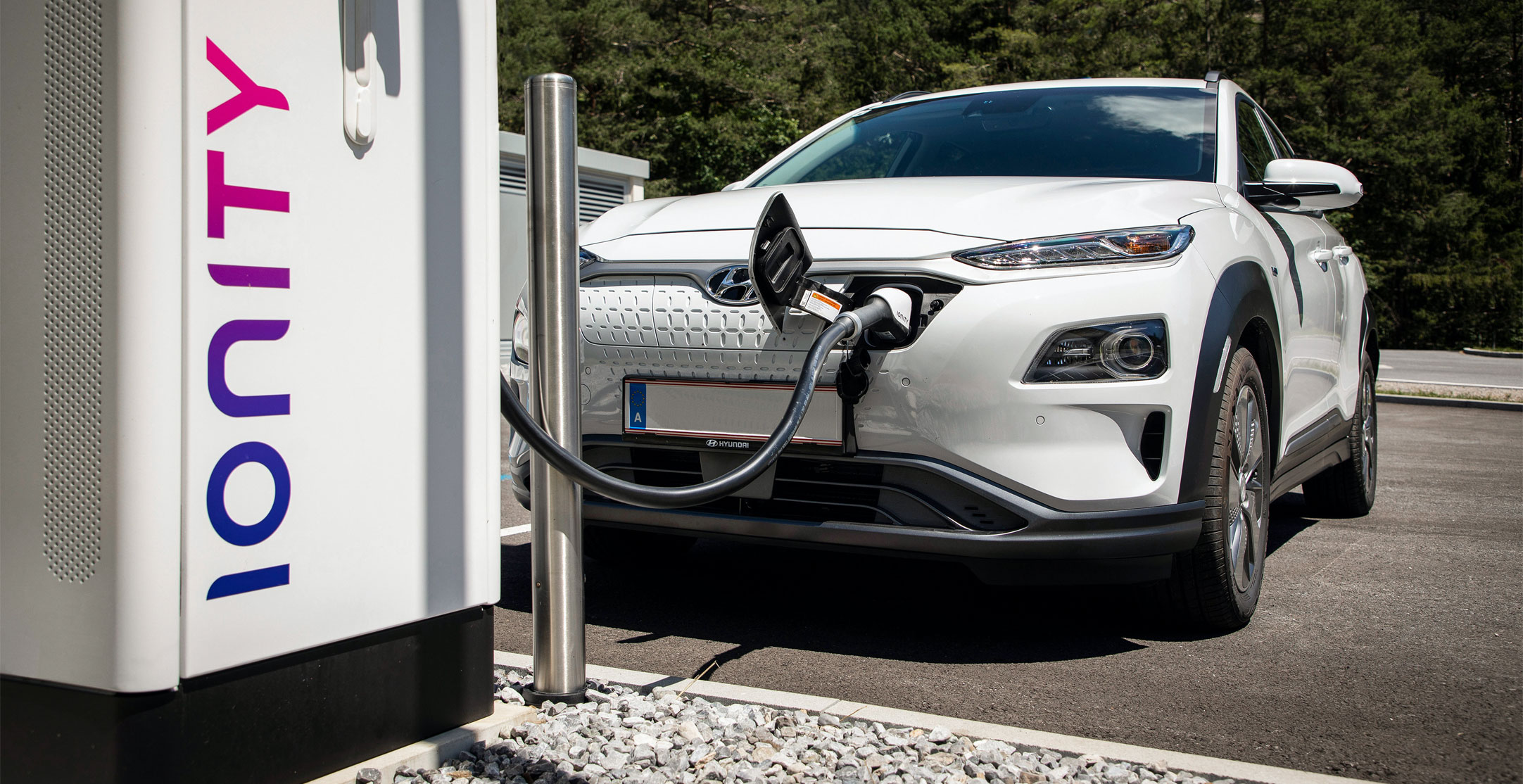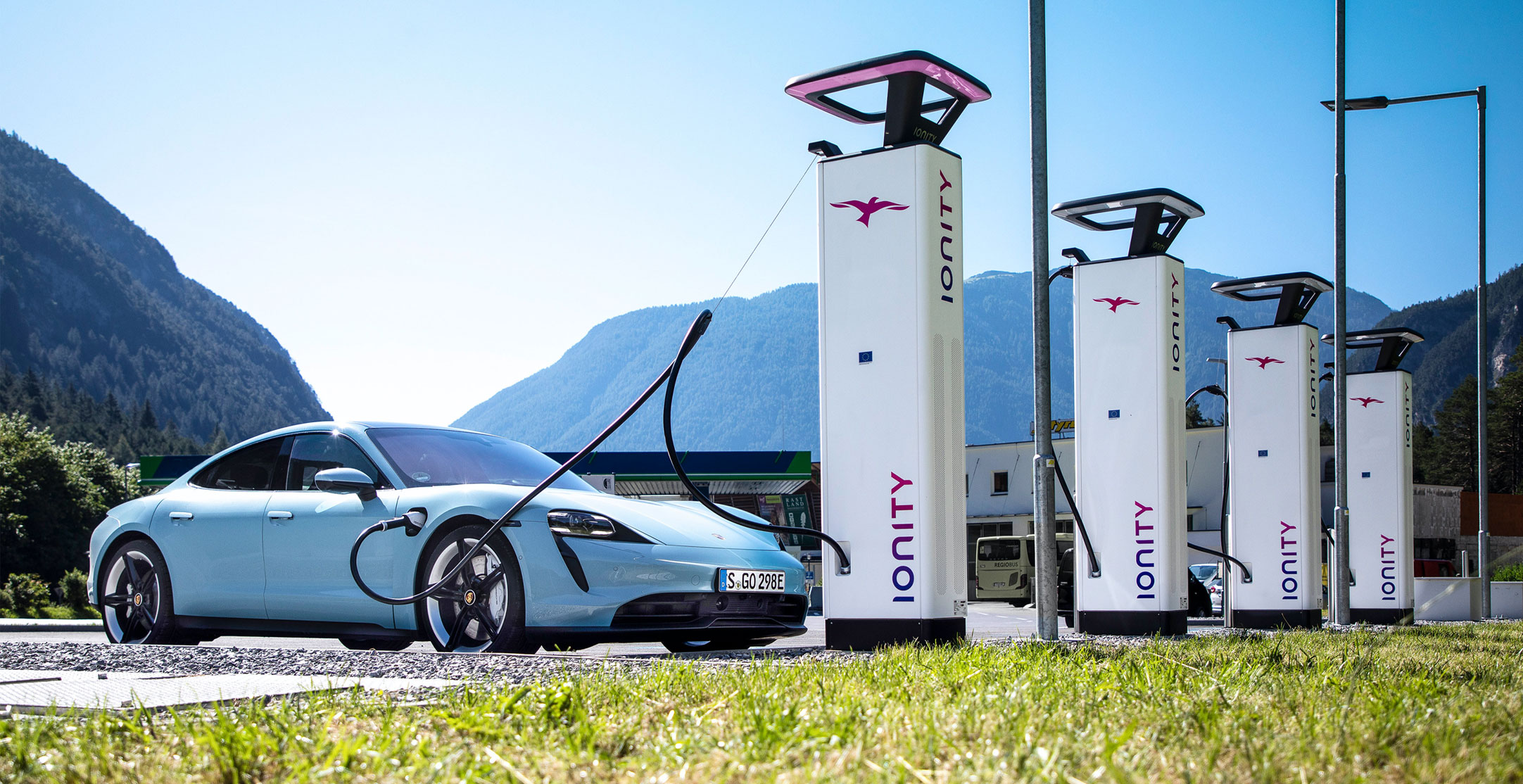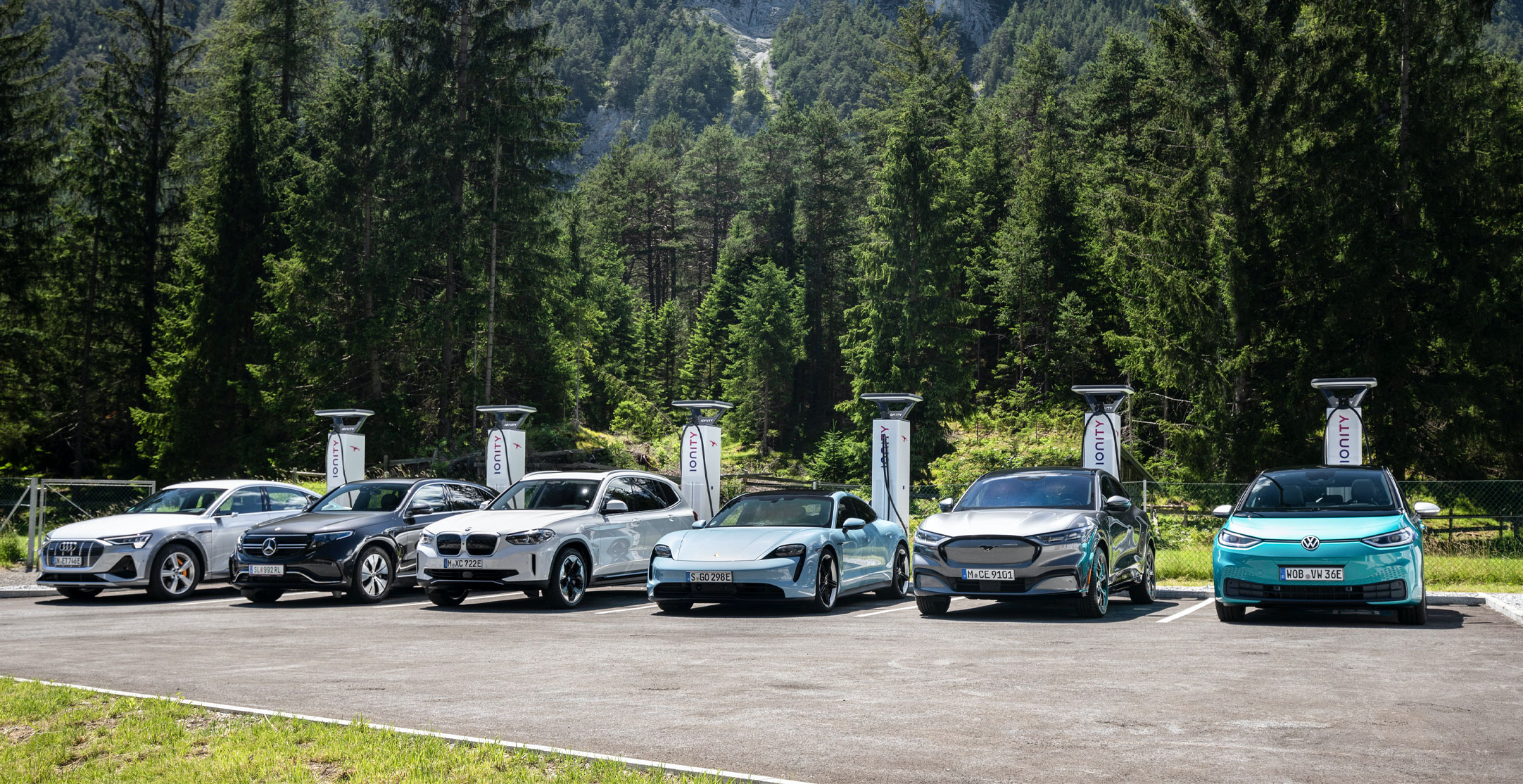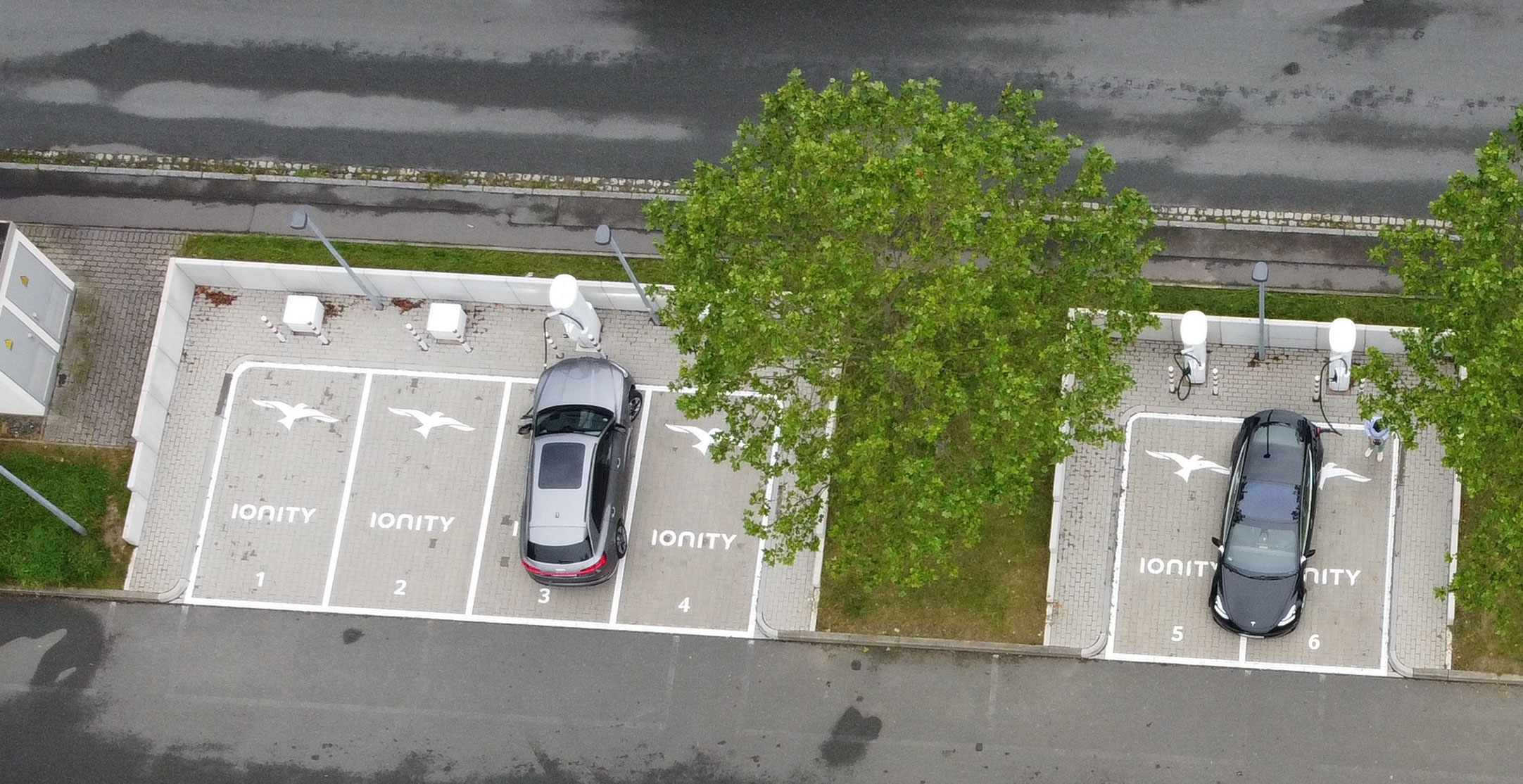
IONITY's high-power chargers are the most powerful ones on the market, with a charging capacity of up to 350 kw.
New Year, Same Electric Commitment
2020 was a disruptor. It unleashed incredible changes in the world we live in today. But besides the changes that hog the headlines, there is another one that is currently taking place. One that’s as immense but a lot more positive – the transition to electric mobility. Driving an electric vehicle is finally becoming as easy and effortless as powering cars with conventional fuels. IONITY’s widespread charging network is playing a crucial role to make this ambition a reality. And our journey has just started. So let’s take a look at the technologies that will keep your electric engine running this year and beyond.
1. Charging Infrastructure
The ability to recharge your EV almost anywhere – at home, at work, or even at the supermarket – makes electric cars more convenient than petrol or diesel ones when making shorter trips in or around town. But what will make them a viable option for all is their ability to travel hassle-free long-distance. This is where IONITY comes in. We believe that driving an EV across Europe should be the new normal, and that a reliable, fast-charging network is the next step towards mass-adoption of EVs.
Even though most available EVs offer enough range to satisfy a typical drive 90% of the time – and the roughly 400 new models coming over the next five years even more so – range anxiety still ranks as the number one reason to hesitate with the purchase of an EV.
IONITY is the common cure for this range anxiety. In just 2020 alone, IONITY has added 123 high-power charging stations with a total of 328 stations to date. That’s a 38% increase in just one year, and let’s not forget what a challenging year it was! While this growth will continue, there is more to it than just numbers.
While IONITY’s focus is on installing high-power charging infrastructure along European highways to enable long-distance driving, the broader task for all players in the e-mobility industry is to give confidence that EVs are reliable, hassle-free and a sound investment not just for tomorrow, but today, too. Part of this is making the charging process itself as simple and intuitive as possible. And rest assured, we’re on it.

2. Plug&Charge
We understand that while stopping along highways, the greatest wish is to get back on the road as soon as possible. That’s why our charging infrastructure aims at making that pitstop as short, and sweet, as possible. How do we do this? By installing an average of four chargers per station to avoid unwanted queues. By delivering up to 350 kW to make charging a vehicle faster than anywhere else.. And by making the charging process itself easy, intuitive and with minimum charger interaction. Not content with just that, we have another ace up our sleeve – Plug&Charge.
The speed of a charging session itself is not the only factor determining how quickly customers are able to continue their journey. The seamlessness of the experience as a whole plays an equally important role. An essential part of this experience is Plug&Charge – a technology which allows the driver to simply drive up to the charging station, plug in their EV, charge, and leave. Everything else is handled by the vehicle and the charger, including payments.
Sounds simple, right? But this is actually more complex than it seems. For an automaker with a proprietary network of chargers and just a few vehicle models, it is a reasonably simple setup. However, ensuring this compatibility across the majority of car brands and their models as well as various mobility service providers (MSP’s), that is a much taller task. Let’s see why.
Besides the communication between the vehicle and the charger to establish a charging session, it is also necessary to verify that the customer has a valid payment contract (which can be done with any MSP, leaving the customer the freedom to choose) and is therefore allowed to charge.
Currently your payment details live on your phone or in your wallet. However, with Plug&Charge, this is essentially stored in the car itself. While liberating, this technology presents a few challenges of its own.
With Plug&Charge, the real-time validation of a user’s data is done without human interaction. So naturally, the whole communication chain needs to be watertight and secure. The only way to do this is through an industry-wide PKI (public key infrastructure).
The hiccup of course was that this PKI wasn’t fully established for EV charging infrastructure. So engineers industry-wide worked together to create a solution. Over the past years charging station manufacturers have been working tirelessly within the industry to establish an industry-wide PKI. They’ve responded encouragingly by arming their workforce with this IT expertise so that Plug&Charge can become as ubiquitous as Plug & Play.
Still, this PKI is the reason why not all EVs are able to Plug&Charge yet. While the Porsche Taycan, for example, has Plug&Charge capabilities, most existing models have not. The same goes for some vehicles that are only now being introduced. Plug&Charge is still in its early days. In coming years, however, we expect to see widespread adoption of this technology, allowing most EV owners to charge at most charging stations conveniently.
Plug&Charge makes your experience simple and easy

3. Interoperability
While the integration of Plug&Charge is ongoing there are other challenges we expect to witness and overcome in 2021. It’s palpable that EVs are beginning to flood the market and will continue to do so in coming years. More than 400 new models will be launched globally by 2025. The good news for consumers is that times of limited choice are over. However, this places enormous strain on solving the issue of interoperability – the ability of the charger hardware to function seamlessly with all electric vehicles.
The first challenge is the sheer variety of EVs that are on the horizon. Even if most of them will share essential components, making sure that the chargers are able to communicate with the influx of new and different models will require seamless interoperability and extensive testing from both IONITY and the automaker. The lessons learned from the initial years of EV development have given us the confidence that we will be able to resolve any issues that arise in our network. While not every challenge is an infrastructure challenge, we work closely with automakers to ensure that their electric vehicles and our hardware work together. The gathered experience flows into our product development and helps us to flag infrastructural hiccups at high speed.
The second, and obvious, result of the EV boom is that significantly more people shall be buying and driving them. Until now, EVs were mostly driven by enthusiasts and early adopters, who tend to be tech savvy. Now, as EVs become more mainstream, we shall face a growing clientele that’s less keen on understanding the inner workings of EV technology, and hence less patient with a process that may not be seamless 100 percent of the time. Things just have to work, and rightly so. No matter the complexity behind it. This makes it even more compelling for us to make the process hassle-free and hence we’re working closely with automakers from the early stages of their EV development.

EV-charging with IONITY means to have the freedom to travel long distance across Europe
4. Battery Storage
Last, but not the least, we will witness the addition of battery storage at our stations over 2021. Our network seeks to provide high-power charging on highways across Europe specifically to enable long-distance driving. This means that occasionally we build charging stations in locations where the power grid cannot supply sufficient energy for high-power charging.
On-site battery storage is the way to overcome this challenge. By storing power in a physical on-site battery that is constantly charged by whatever power is available from the grid, the charging station is able to handle the peak demands of charging several cars simultaneously or the charging of one vehicle at higher speeds.
We currently use battery storage at selected sites to learn about the use cases, bolster the capacity of our stations, and improve our infrastructure at large. For example, we have remote sites in Spain that use battery storage to take the 20kW power available from the local grid and yet allow significantly higher charging speeds. Another example is at some of our UK sites where we use batteries to ‘boost’ site power to enable multiple EVs to charge at the same time at 350kW power. While the battery storage technology is not a new concept, using it in this manner is, and we are certainly looking into options of how it may support the IONITY network in the future.
Putting you in charge
To sum up, 2021 is a year of great power and potential. It’s a year when the growing choice in the EV market will be complemented with the maturing EV charging infrastructure. And we’re doing our best to keep your vehicles, and our commitment, fully charged.

